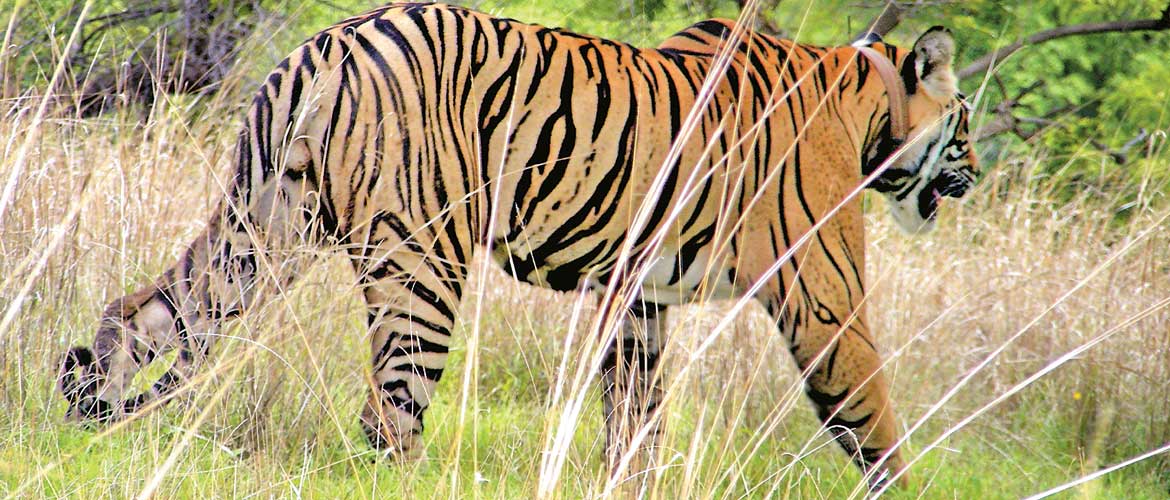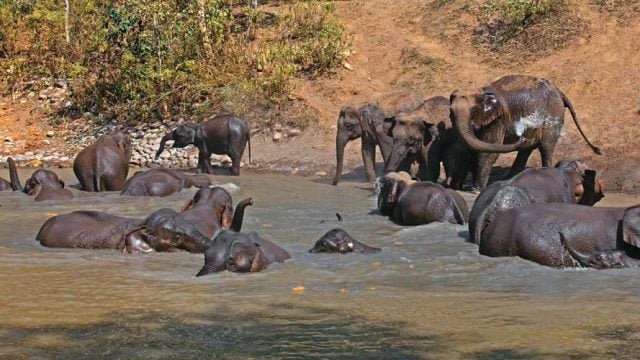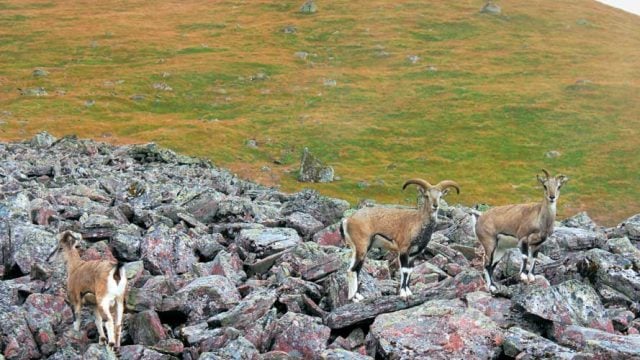Sariska Tiger Reserve has been known for offering the best tiger sightings for years, but
ABOUT SARISKA TIGER RESERVE
Sariska was established as a Tiger Reserve in 1978. Before independence, the reserve was part of the erstwhile Alwar state. In 1955, the central government declared hunting, shooting, trapping or capturing of wild animals as unlawful. In 1958, the reserve to a sanctuary, and later, the areas contiguous to the sanctuary were also included. There are 16 revenue villages and cattle camps inside the park’s boundaries. The semi-arid Aravalli forest is reeling under enormous human and live-stock pressures.

The poachers who had killed all of Sariska tigers (according to a Project Tiger report, there were 24 tigers in the reserve in 1997) are said to have received help from the villagers, who perceived these tigers as a threat to their livestock. The huge number of pilgrims visiting the temples in Sariska has also adversely affected the ecosystem of the forest. If given proper protection, these semi-arid forests can support high ungulate (camels, horses, hippos and other herbivorous mam-mals) population.
ORIENTATION
Visitors enter the reserve from the Sariska Gate after paying their fee at the counter nearby. The standard itinerary includes taking the main road to Pandupol, which goes past the Karnakabas lake, Brahmnath, Kalighati Chauki and Bhaironghati. Those who have more time, can take a detour to Kalighati for the Kankwari Fort. This is located to the west of the reserve’s core area. One can visit the Neelkanth Mahadeva temple via the exit at Tehla Gate (located south of the reserve).
Almost all of Sariska has a hilly terrain dominated by the Aravalli which runs from north to south along the park’s boundary.

There are two vast plateaus in the range, each 5km wide. These are named Kankwari and Keraska. The park itself varies in altitude from 270–360m. There are also three large lakes within the park – Mangalsar (also known as Mansarovar), Siliserh and Somasagar. They offer a beautiful setting for photography.
◆Entry fee Indians ₹125, Foreigners ₹570 Vehicle fee ₹125 Video camera ₹600 Timings 6.30–9.30am, 2.30– 6.30pm. For guides, enquire at the hotel you are staying.
Tip Diesel vehicles are allowed to ride only on the tarmac routes inside the jungle.
THINGS TO SEE AND DO
Besides tigers, the reserve is also home to langur and nilgai and a rich avifauna that includes species such as the white-breasted kingfisher and peafowl, grey patridges and tree pies. The city as well as the tiger reserve are replete with structures of historical interest.
Aravalli Drive
A drive on the Aravalli mountain range is a fascinating experience. One can start this journey from Kankwari, a plateau located 15-km-uphill from Sariska. The road cuts through dense forests and takes you to the Kankwari Fort, situated in the middle of the plateau. The panoramic views of the city below and the surrounding areas from the fort are absolutely stunning.
It is said that Aurangzeb had imprisoned his brother Dara Shikoh in the Kankwari Fort. This plateau is also accessible by a metalled road running from Tehla via Rajoregarh, an ancient settlement known for its 9th century Shiva temples.

There is no public transportation in Sariska, so you will have to hire a jeep from a lodge or a travel agency, or bring your own vehicle. Jeeps are available for hire near the reserve’s office, at Tiger’s Den and Sariska Palace. A jeep will cost Rs.800 for 3 hours. A day trip from Alwar will cost you ₹1,500 approximately.
Pandupol
To the south-east of RTDC’s Tiger Den in Sariska is Pandupol, a lovely spot that has mythological significance. It is believed that the Pandavas had spent a part of their agyatvas (exile) at this location. Pandupol is also the name of a 35-ft-waterfall arising from near the crest of the Aravalli Ridge, where there’s a deep fissure. It is said to have been created by Bhima.
Near the waterfall, which is accessible by road, there is an old Hanuman temple. The road leading to the temple is full of langurs, peafowl, spurfowl, and the ubiquitous tree pies. There is a large mela organised at Pandupol every year, which attracts thousands of pilgrims from across the country.
Every Tuesday, pilgrims are permitted to visit the shrine, by driving through the park. If you are interested only in seeing wildlife, it’s best to avoid Tuesdays.
The Temple Trail
Neelkanth Mahadeva, a temple town near Tehla village, in the outskirts of Sariska, houses the ruins of over 300 Hindu and Jain temples constructed between the 8th and 12th centuries. The carvings here resemble those of the Chandela rulers of Khajuraho. Historians suggest these carvings date back to 9th–10th centuries.
The Naldeshwar shrine close by attracts several pilgrims all year round. Located just off the main road to Sariska from Alwar, Naldeshwar is an old Shiv temple. The approach to the temple, surrounded by dense forests, can be accessed only by a 2-km-long walk from the main road.
Talvriksh, on the northern edge of the park, is another centre for pilgrimage in Rajasthan. It has a temple with both hot and cold springs, and is located close to the park on the Narayaniji Road. The Bhartrihari temple, located to the south of Kushalgarh, and within the sanctuary area, is famous all over Rajasthan for its fairs. It is named after the ancient ruler Bhartrihari of Ujjain, who renounced his kingdom and became a sage.

WHERE TO STAY
Sariska has a few good options to stay, but it’s a better base than Alwar for those wishing to take an early morning ride through the park.
Heritage Options
The Sariska Palace (Tel: 2841323/ 25; Tariff: ₹10,000–21,500) is set in a large, well-manicured lawn. The construction of Sariska Palace was started by Maharaja Mangal Singh, but was completed in 1894 by Maharaja Jai Singh of Alwar. During the latter’s reign, arrangements were made for water harvesting in the forest. Wells were dug, streams dammed, and water channelised to suitable locations. Some of the shikar trophies and photographs of old shikars from this time can still be seen at the Sariska Palace. The hotel tariff includes all meals. The hotel arranges safaris as well as picnic packages to the park.
Others
The RTDC Tiger’s Den (Tel: 0144-2841342/ 44; Tariff: ₹2,400–5,000, with two meals) is ideally located for quick access to the park and is convenient for booking jungle safaris. The place has a restaurant as well. Sariska Tiger Heaven (Cell: 09251016312; Tariff: ₹10,000–12,000, with meals) has a restaurant and swimming pool.

Away from the park, at Village Thana Ghazi (7km before Sariska), is the high-end Hotel Amanbagh (Tel: 01465-223333; Tariff: ₹24,000-42,000) of Aman Resorts fame. It has a spa, swimming pool, and also arranges safaris. It has indoor game facilities as well. Alwar Bagh (Cell: 09587508111; Tariff: ₹7,000–8,500), on Jaipur Road in Dhawala village, has clean, spacious rooms, good food and lots of indoor and outdoor activities for tourists. Sariska Tiger Camp (Tel: 2885311/ 12, Cell: 09314017210; Tariff: ₹4,500–5,500) in the same village offers trekking and camel/ horse rides on request.
Other options include Gulmohar Sariska Resort (Cell: 09829553395; Tariff: ₹2,800) in Virat Nagar and Amrit Resort (Tel: 2886134, Cell: 09828166320, 09983720000; Tariff: ₹2,500–3,100) located on Jaipur-Sariska Road.
WHERE TO EAT
There are no restaurant options in Sariska apart from your hotel. The halwais of Alwar, however, offer the famous palang torh (milk cake). A visit to one of Alwar’s most popular eateries, the Prem Pavitra Res-taurant, is a must. Tuck into their delicious paranthas, gajar-ka-halwa and kheer. Do not miss Rajasthan’s favourite – the spicy mirchi-ka-achaar. Prem Pavitra’s reputation rests on its pure vegetarian fare and organically grown vegetables.
AROUND SARISKA TIGER RESERVE
Narayanpur Village (25km)
To the west of Talvriksh is Narayanpur village, home to the Narayani Mata temple. It is said that the first Sati (immolation by fire) in North India took place at this location.
Bhangarh-Ajaibgarh-Pratapgarh
Located within the bounds of Sariska are the remnants of three ancient settlements. Madho Singh, son of the Mughal general Man Singh of Amber, built Bhangarh Fort in the southern tip of the sanctuary, in 1613. It was abandoned soon after being built. From here, if you head north-west to Ajaibgarh, you will find a beautiful old fort situated along the forest edge between Bhangarh and Pratapgarh.
The grandson of Madho Singh, Ajab Singh Rajawat, built the Ajaibgarh Fort. In good condition even today, the fort offers a lovely view of the eponymous walled town. Heading westwards, you will reach Pratapgarh, a hill fort that dominates the region. You can reach this place either from within the sanctuary or from the main road outside it.
Siliserh Lake (24 km)
Barely 13km from Alwar, Siliserh is a beautiful spot – a lake surrounded by a ring of hills. Here, overlooking the lake, is a hunting lodge built by Maharaj Viney Singh for his queen. Taken over by Rajasthan Tourism, it now serves as a hotel – the Lake Palace (Tel: 0144-2907222-23; Tariff: ₹2,750–4,145, with two meals).

The views from the Lake Palace are impressive. Boating facilities are available. You may wish to carry a hamper to picnic by the lake’s edge or go for walks along its shore and spot hundreds of birds. In winter, visitors may even spot crocodiles sunning themselves on the banks.
GETTING THERE
Rail Nearest railhead: Alwar (35 km/ 1hr) is connected to Delhi by Jaipur- Delhi Express. Taxi costs ₹1,000
Road Take NH8 to Shahpura via Kot Putli and Patwa; 1km short of Shahpura, before the toll gate, there is a left turn for Sariska. This is a 40-km drive. You will cross Bairat and Thana Gazi villages en route
FAST FACTS
When to go November–March, although the best wildife spotting takes place in summers
Wildlife/ Forest Dept offices
Field Director, Project Tiger
Sariska Tiger Reserve, Sariska PO
Alwar District
Tel: 0144-2841333Rajasthan Tourism
Tourist Reception Centre
Opp Railway Station, Alwar
Tel 2347348
STD code 0144
State Rajasthan
Location In Aravalli hills, 35km from Alwar city in northeast Rajasthan
Distance 108km NE of Jaipur, 236km SW of Delhi
Route from Jaipur NH8 to Shahpura via Chandwaji; state road to Sariska via Thana Gazi
Route from Delhi NH8 to Shahpura; rest as above
OT Getaway Guides
Rajasthan
Sariska Tiger Reserve





